Different Types of Employment Contracts and Their Advantages and Disadvantages
VerifiedAdded on 2023/01/05
|13
|3598
|46
AI Summary
This article discusses the four types of employment contracts - permanent, part-time, zero hour, and fixed term contracts. It explains the advantages and disadvantages of each contract and provides examples from Tesco and Unilever. It also highlights the importance of hiring the right employees and the impact of different contractual approaches on organizational performance.
Contribute Materials
Your contribution can guide someone’s learning journey. Share your
documents today.

Managing Human
Resources
Resources
Secure Best Marks with AI Grader
Need help grading? Try our AI Grader for instant feedback on your assignments.
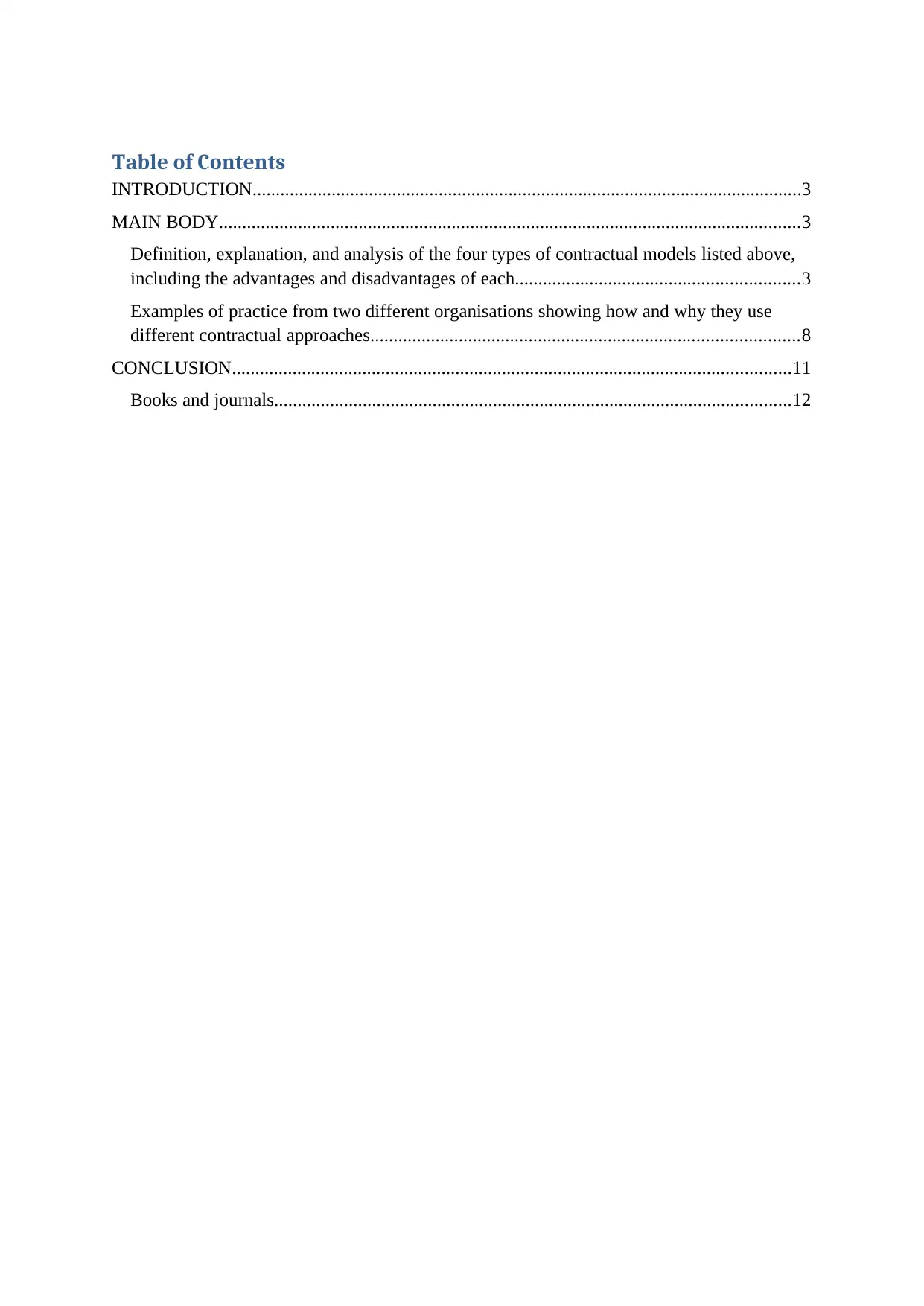
Table of Contents
INTRODUCTION......................................................................................................................3
MAIN BODY.............................................................................................................................3
Definition, explanation, and analysis of the four types of contractual models listed above,
including the advantages and disadvantages of each.............................................................3
Examples of practice from two different organisations showing how and why they use
different contractual approaches............................................................................................8
CONCLUSION........................................................................................................................11
Books and journals...............................................................................................................12
INTRODUCTION......................................................................................................................3
MAIN BODY.............................................................................................................................3
Definition, explanation, and analysis of the four types of contractual models listed above,
including the advantages and disadvantages of each.............................................................3
Examples of practice from two different organisations showing how and why they use
different contractual approaches............................................................................................8
CONCLUSION........................................................................................................................11
Books and journals...............................................................................................................12
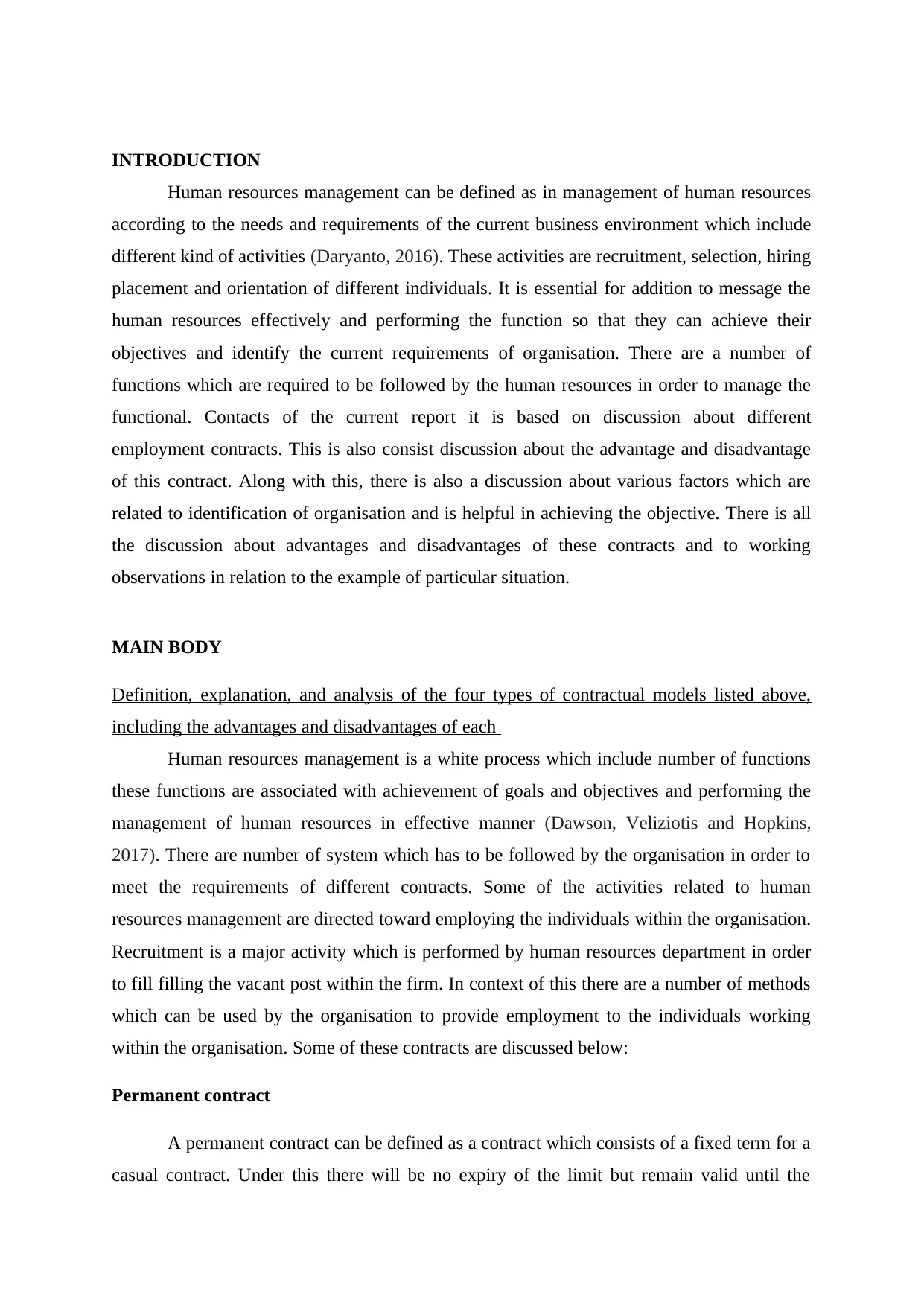
INTRODUCTION
Human resources management can be defined as in management of human resources
according to the needs and requirements of the current business environment which include
different kind of activities (Daryanto, 2016). These activities are recruitment, selection, hiring
placement and orientation of different individuals. It is essential for addition to message the
human resources effectively and performing the function so that they can achieve their
objectives and identify the current requirements of organisation. There are a number of
functions which are required to be followed by the human resources in order to manage the
functional. Contacts of the current report it is based on discussion about different
employment contracts. This is also consist discussion about the advantage and disadvantage
of this contract. Along with this, there is also a discussion about various factors which are
related to identification of organisation and is helpful in achieving the objective. There is all
the discussion about advantages and disadvantages of these contracts and to working
observations in relation to the example of particular situation.
MAIN BODY
Definition, explanation, and analysis of the four types of contractual models listed above,
including the advantages and disadvantages of each
Human resources management is a white process which include number of functions
these functions are associated with achievement of goals and objectives and performing the
management of human resources in effective manner (Dawson, Veliziotis and Hopkins,
2017). There are number of system which has to be followed by the organisation in order to
meet the requirements of different contracts. Some of the activities related to human
resources management are directed toward employing the individuals within the organisation.
Recruitment is a major activity which is performed by human resources department in order
to fill filling the vacant post within the firm. In context of this there are a number of methods
which can be used by the organisation to provide employment to the individuals working
within the organisation. Some of these contracts are discussed below:
Permanent contract
A permanent contract can be defined as a contract which consists of a fixed term for a
casual contract. Under this there will be no expiry of the limit but remain valid until the
Human resources management can be defined as in management of human resources
according to the needs and requirements of the current business environment which include
different kind of activities (Daryanto, 2016). These activities are recruitment, selection, hiring
placement and orientation of different individuals. It is essential for addition to message the
human resources effectively and performing the function so that they can achieve their
objectives and identify the current requirements of organisation. There are a number of
functions which are required to be followed by the human resources in order to manage the
functional. Contacts of the current report it is based on discussion about different
employment contracts. This is also consist discussion about the advantage and disadvantage
of this contract. Along with this, there is also a discussion about various factors which are
related to identification of organisation and is helpful in achieving the objective. There is all
the discussion about advantages and disadvantages of these contracts and to working
observations in relation to the example of particular situation.
MAIN BODY
Definition, explanation, and analysis of the four types of contractual models listed above,
including the advantages and disadvantages of each
Human resources management is a white process which include number of functions
these functions are associated with achievement of goals and objectives and performing the
management of human resources in effective manner (Dawson, Veliziotis and Hopkins,
2017). There are number of system which has to be followed by the organisation in order to
meet the requirements of different contracts. Some of the activities related to human
resources management are directed toward employing the individuals within the organisation.
Recruitment is a major activity which is performed by human resources department in order
to fill filling the vacant post within the firm. In context of this there are a number of methods
which can be used by the organisation to provide employment to the individuals working
within the organisation. Some of these contracts are discussed below:
Permanent contract
A permanent contract can be defined as a contract which consists of a fixed term for a
casual contract. Under this there will be no expiry of the limit but remain valid until the
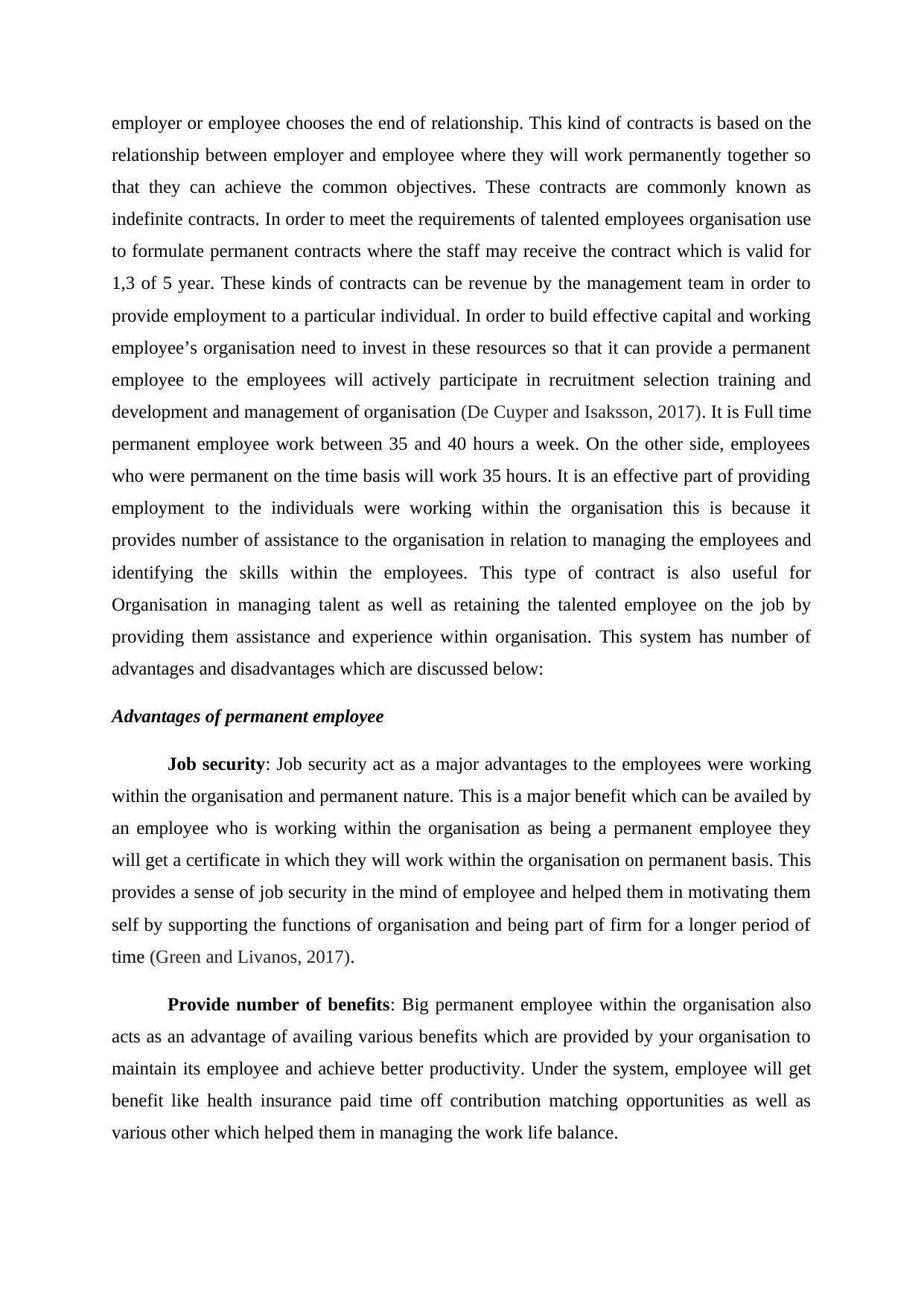
employer or employee chooses the end of relationship. This kind of contracts is based on the
relationship between employer and employee where they will work permanently together so
that they can achieve the common objectives. These contracts are commonly known as
indefinite contracts. In order to meet the requirements of talented employees organisation use
to formulate permanent contracts where the staff may receive the contract which is valid for
1,3 of 5 year. These kinds of contracts can be revenue by the management team in order to
provide employment to a particular individual. In order to build effective capital and working
employee’s organisation need to invest in these resources so that it can provide a permanent
employee to the employees will actively participate in recruitment selection training and
development and management of organisation (De Cuyper and Isaksson, 2017). It is Full time
permanent employee work between 35 and 40 hours a week. On the other side, employees
who were permanent on the time basis will work 35 hours. It is an effective part of providing
employment to the individuals were working within the organisation this is because it
provides number of assistance to the organisation in relation to managing the employees and
identifying the skills within the employees. This type of contract is also useful for
Organisation in managing talent as well as retaining the talented employee on the job by
providing them assistance and experience within organisation. This system has number of
advantages and disadvantages which are discussed below:
Advantages of permanent employee
Job security: Job security act as a major advantages to the employees were working
within the organisation and permanent nature. This is a major benefit which can be availed by
an employee who is working within the organisation as being a permanent employee they
will get a certificate in which they will work within the organisation on permanent basis. This
provides a sense of job security in the mind of employee and helped them in motivating them
self by supporting the functions of organisation and being part of firm for a longer period of
time (Green and Livanos, 2017).
Provide number of benefits: Big permanent employee within the organisation also
acts as an advantage of availing various benefits which are provided by your organisation to
maintain its employee and achieve better productivity. Under the system, employee will get
benefit like health insurance paid time off contribution matching opportunities as well as
various other which helped them in managing the work life balance.
relationship between employer and employee where they will work permanently together so
that they can achieve the common objectives. These contracts are commonly known as
indefinite contracts. In order to meet the requirements of talented employees organisation use
to formulate permanent contracts where the staff may receive the contract which is valid for
1,3 of 5 year. These kinds of contracts can be revenue by the management team in order to
provide employment to a particular individual. In order to build effective capital and working
employee’s organisation need to invest in these resources so that it can provide a permanent
employee to the employees will actively participate in recruitment selection training and
development and management of organisation (De Cuyper and Isaksson, 2017). It is Full time
permanent employee work between 35 and 40 hours a week. On the other side, employees
who were permanent on the time basis will work 35 hours. It is an effective part of providing
employment to the individuals were working within the organisation this is because it
provides number of assistance to the organisation in relation to managing the employees and
identifying the skills within the employees. This type of contract is also useful for
Organisation in managing talent as well as retaining the talented employee on the job by
providing them assistance and experience within organisation. This system has number of
advantages and disadvantages which are discussed below:
Advantages of permanent employee
Job security: Job security act as a major advantages to the employees were working
within the organisation and permanent nature. This is a major benefit which can be availed by
an employee who is working within the organisation as being a permanent employee they
will get a certificate in which they will work within the organisation on permanent basis. This
provides a sense of job security in the mind of employee and helped them in motivating them
self by supporting the functions of organisation and being part of firm for a longer period of
time (Green and Livanos, 2017).
Provide number of benefits: Big permanent employee within the organisation also
acts as an advantage of availing various benefits which are provided by your organisation to
maintain its employee and achieve better productivity. Under the system, employee will get
benefit like health insurance paid time off contribution matching opportunities as well as
various other which helped them in managing the work life balance.
Secure Best Marks with AI Grader
Need help grading? Try our AI Grader for instant feedback on your assignments.
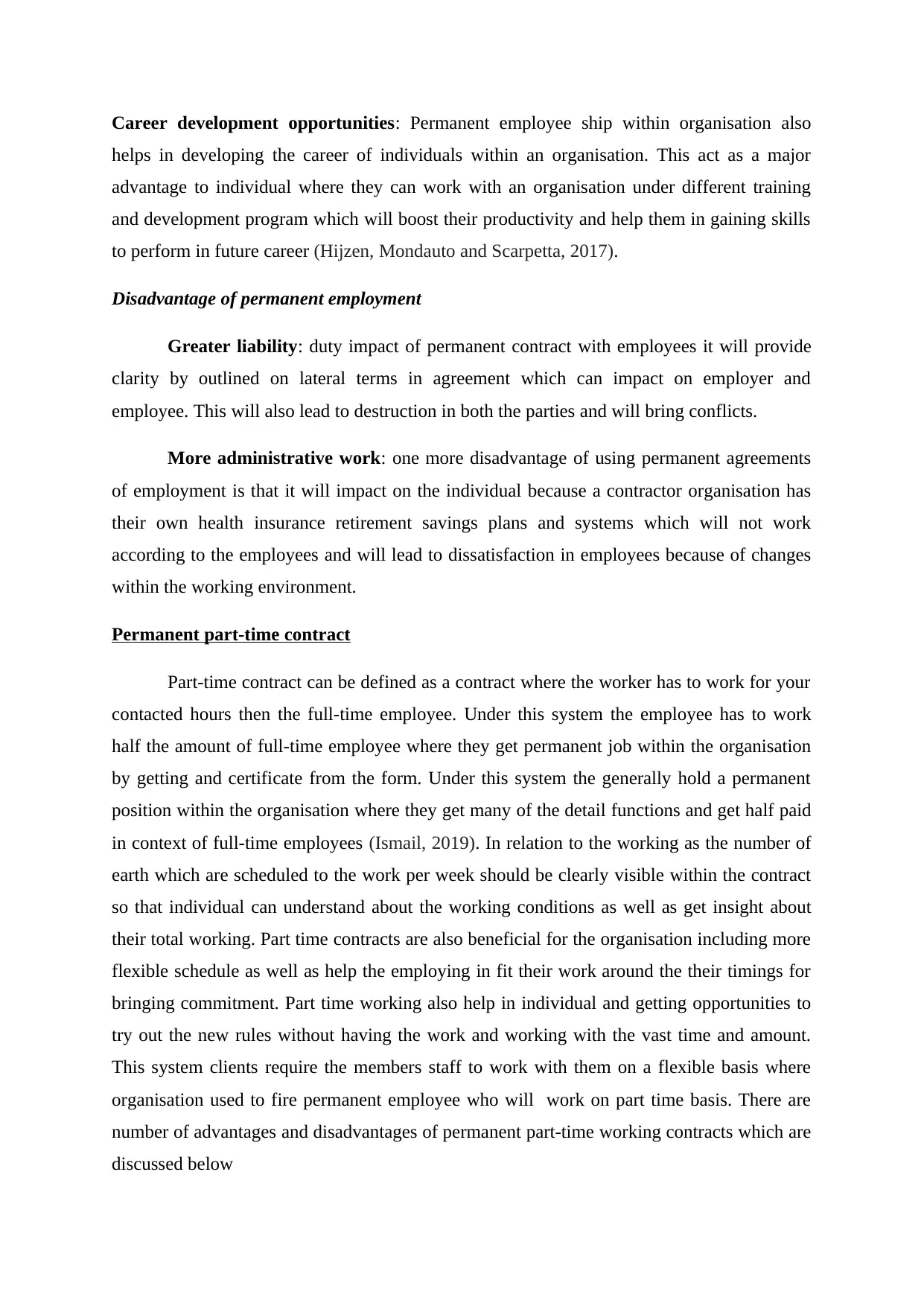
Career development opportunities: Permanent employee ship within organisation also
helps in developing the career of individuals within an organisation. This act as a major
advantage to individual where they can work with an organisation under different training
and development program which will boost their productivity and help them in gaining skills
to perform in future career (Hijzen, Mondauto and Scarpetta, 2017).
Disadvantage of permanent employment
Greater liability: duty impact of permanent contract with employees it will provide
clarity by outlined on lateral terms in agreement which can impact on employer and
employee. This will also lead to destruction in both the parties and will bring conflicts.
More administrative work: one more disadvantage of using permanent agreements
of employment is that it will impact on the individual because a contractor organisation has
their own health insurance retirement savings plans and systems which will not work
according to the employees and will lead to dissatisfaction in employees because of changes
within the working environment.
Permanent part-time contract
Part-time contract can be defined as a contract where the worker has to work for your
contacted hours then the full-time employee. Under this system the employee has to work
half the amount of full-time employee where they get permanent job within the organisation
by getting and certificate from the form. Under this system the generally hold a permanent
position within the organisation where they get many of the detail functions and get half paid
in context of full-time employees (Ismail, 2019). In relation to the working as the number of
earth which are scheduled to the work per week should be clearly visible within the contract
so that individual can understand about the working conditions as well as get insight about
their total working. Part time contracts are also beneficial for the organisation including more
flexible schedule as well as help the employing in fit their work around the their timings for
bringing commitment. Part time working also help in individual and getting opportunities to
try out the new rules without having the work and working with the vast time and amount.
This system clients require the members staff to work with them on a flexible basis where
organisation used to fire permanent employee who will work on part time basis. There are
number of advantages and disadvantages of permanent part-time working contracts which are
discussed below
helps in developing the career of individuals within an organisation. This act as a major
advantage to individual where they can work with an organisation under different training
and development program which will boost their productivity and help them in gaining skills
to perform in future career (Hijzen, Mondauto and Scarpetta, 2017).
Disadvantage of permanent employment
Greater liability: duty impact of permanent contract with employees it will provide
clarity by outlined on lateral terms in agreement which can impact on employer and
employee. This will also lead to destruction in both the parties and will bring conflicts.
More administrative work: one more disadvantage of using permanent agreements
of employment is that it will impact on the individual because a contractor organisation has
their own health insurance retirement savings plans and systems which will not work
according to the employees and will lead to dissatisfaction in employees because of changes
within the working environment.
Permanent part-time contract
Part-time contract can be defined as a contract where the worker has to work for your
contacted hours then the full-time employee. Under this system the employee has to work
half the amount of full-time employee where they get permanent job within the organisation
by getting and certificate from the form. Under this system the generally hold a permanent
position within the organisation where they get many of the detail functions and get half paid
in context of full-time employees (Ismail, 2019). In relation to the working as the number of
earth which are scheduled to the work per week should be clearly visible within the contract
so that individual can understand about the working conditions as well as get insight about
their total working. Part time contracts are also beneficial for the organisation including more
flexible schedule as well as help the employing in fit their work around the their timings for
bringing commitment. Part time working also help in individual and getting opportunities to
try out the new rules without having the work and working with the vast time and amount.
This system clients require the members staff to work with them on a flexible basis where
organisation used to fire permanent employee who will work on part time basis. There are
number of advantages and disadvantages of permanent part-time working contracts which are
discussed below
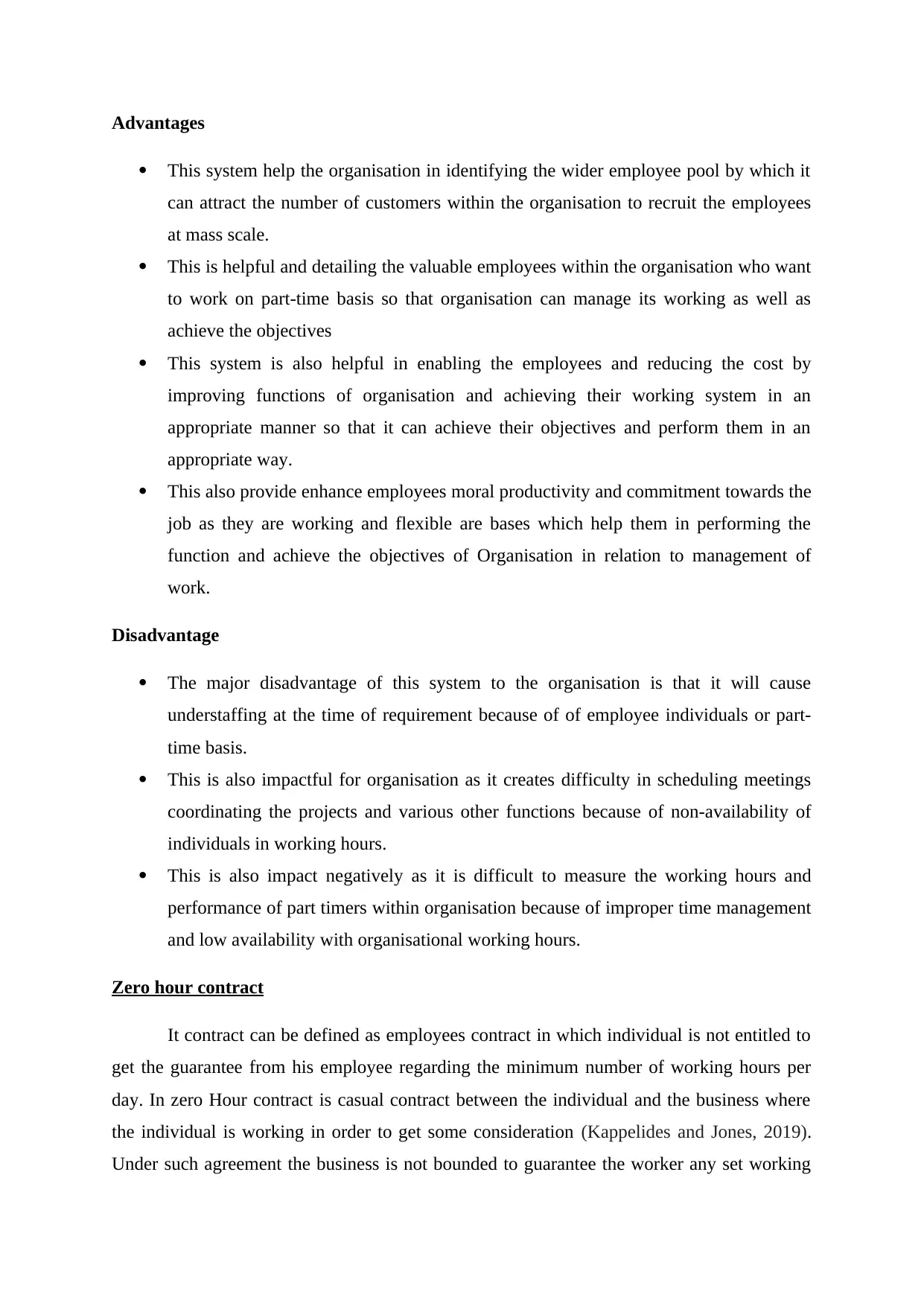
Advantages
This system help the organisation in identifying the wider employee pool by which it
can attract the number of customers within the organisation to recruit the employees
at mass scale.
This is helpful and detailing the valuable employees within the organisation who want
to work on part-time basis so that organisation can manage its working as well as
achieve the objectives
This system is also helpful in enabling the employees and reducing the cost by
improving functions of organisation and achieving their working system in an
appropriate manner so that it can achieve their objectives and perform them in an
appropriate way.
This also provide enhance employees moral productivity and commitment towards the
job as they are working and flexible are bases which help them in performing the
function and achieve the objectives of Organisation in relation to management of
work.
Disadvantage
The major disadvantage of this system to the organisation is that it will cause
understaffing at the time of requirement because of of employee individuals or part-
time basis.
This is also impactful for organisation as it creates difficulty in scheduling meetings
coordinating the projects and various other functions because of non-availability of
individuals in working hours.
This is also impact negatively as it is difficult to measure the working hours and
performance of part timers within organisation because of improper time management
and low availability with organisational working hours.
Zero hour contract
It contract can be defined as employees contract in which individual is not entitled to
get the guarantee from his employee regarding the minimum number of working hours per
day. In zero Hour contract is casual contract between the individual and the business where
the individual is working in order to get some consideration (Kappelides and Jones, 2019).
Under such agreement the business is not bounded to guarantee the worker any set working
This system help the organisation in identifying the wider employee pool by which it
can attract the number of customers within the organisation to recruit the employees
at mass scale.
This is helpful and detailing the valuable employees within the organisation who want
to work on part-time basis so that organisation can manage its working as well as
achieve the objectives
This system is also helpful in enabling the employees and reducing the cost by
improving functions of organisation and achieving their working system in an
appropriate manner so that it can achieve their objectives and perform them in an
appropriate way.
This also provide enhance employees moral productivity and commitment towards the
job as they are working and flexible are bases which help them in performing the
function and achieve the objectives of Organisation in relation to management of
work.
Disadvantage
The major disadvantage of this system to the organisation is that it will cause
understaffing at the time of requirement because of of employee individuals or part-
time basis.
This is also impactful for organisation as it creates difficulty in scheduling meetings
coordinating the projects and various other functions because of non-availability of
individuals in working hours.
This is also impact negatively as it is difficult to measure the working hours and
performance of part timers within organisation because of improper time management
and low availability with organisational working hours.
Zero hour contract
It contract can be defined as employees contract in which individual is not entitled to
get the guarantee from his employee regarding the minimum number of working hours per
day. In zero Hour contract is casual contract between the individual and the business where
the individual is working in order to get some consideration (Kappelides and Jones, 2019).
Under such agreement the business is not bounded to guarantee the worker any set working
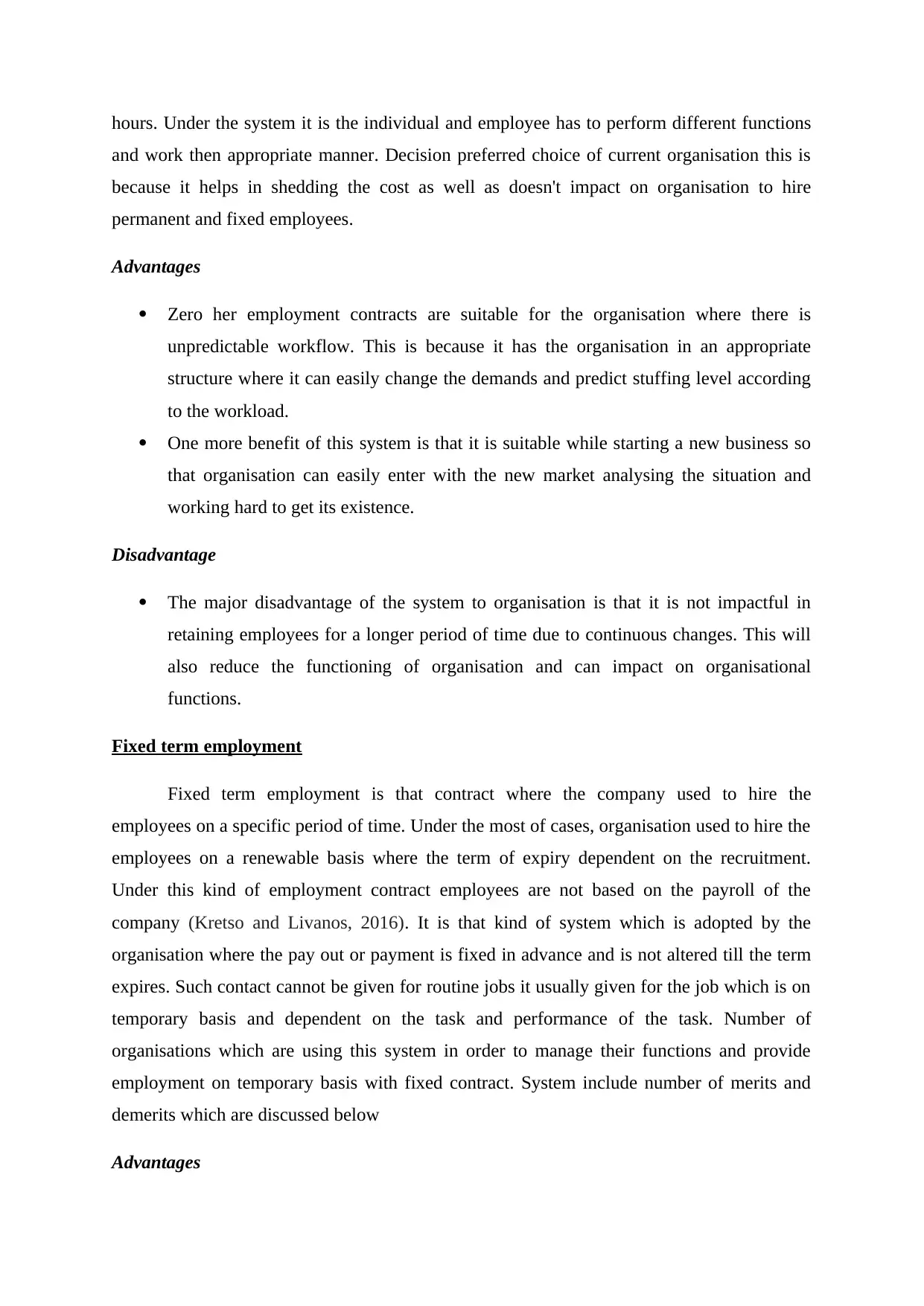
hours. Under the system it is the individual and employee has to perform different functions
and work then appropriate manner. Decision preferred choice of current organisation this is
because it helps in shedding the cost as well as doesn't impact on organisation to hire
permanent and fixed employees.
Advantages
Zero her employment contracts are suitable for the organisation where there is
unpredictable workflow. This is because it has the organisation in an appropriate
structure where it can easily change the demands and predict stuffing level according
to the workload.
One more benefit of this system is that it is suitable while starting a new business so
that organisation can easily enter with the new market analysing the situation and
working hard to get its existence.
Disadvantage
The major disadvantage of the system to organisation is that it is not impactful in
retaining employees for a longer period of time due to continuous changes. This will
also reduce the functioning of organisation and can impact on organisational
functions.
Fixed term employment
Fixed term employment is that contract where the company used to hire the
employees on a specific period of time. Under the most of cases, organisation used to hire the
employees on a renewable basis where the term of expiry dependent on the recruitment.
Under this kind of employment contract employees are not based on the payroll of the
company (Kretso and Livanos, 2016). It is that kind of system which is adopted by the
organisation where the pay out or payment is fixed in advance and is not altered till the term
expires. Such contact cannot be given for routine jobs it usually given for the job which is on
temporary basis and dependent on the task and performance of the task. Number of
organisations which are using this system in order to manage their functions and provide
employment on temporary basis with fixed contract. System include number of merits and
demerits which are discussed below
Advantages
and work then appropriate manner. Decision preferred choice of current organisation this is
because it helps in shedding the cost as well as doesn't impact on organisation to hire
permanent and fixed employees.
Advantages
Zero her employment contracts are suitable for the organisation where there is
unpredictable workflow. This is because it has the organisation in an appropriate
structure where it can easily change the demands and predict stuffing level according
to the workload.
One more benefit of this system is that it is suitable while starting a new business so
that organisation can easily enter with the new market analysing the situation and
working hard to get its existence.
Disadvantage
The major disadvantage of the system to organisation is that it is not impactful in
retaining employees for a longer period of time due to continuous changes. This will
also reduce the functioning of organisation and can impact on organisational
functions.
Fixed term employment
Fixed term employment is that contract where the company used to hire the
employees on a specific period of time. Under the most of cases, organisation used to hire the
employees on a renewable basis where the term of expiry dependent on the recruitment.
Under this kind of employment contract employees are not based on the payroll of the
company (Kretso and Livanos, 2016). It is that kind of system which is adopted by the
organisation where the pay out or payment is fixed in advance and is not altered till the term
expires. Such contact cannot be given for routine jobs it usually given for the job which is on
temporary basis and dependent on the task and performance of the task. Number of
organisations which are using this system in order to manage their functions and provide
employment on temporary basis with fixed contract. System include number of merits and
demerits which are discussed below
Advantages
Paraphrase This Document
Need a fresh take? Get an instant paraphrase of this document with our AI Paraphraser
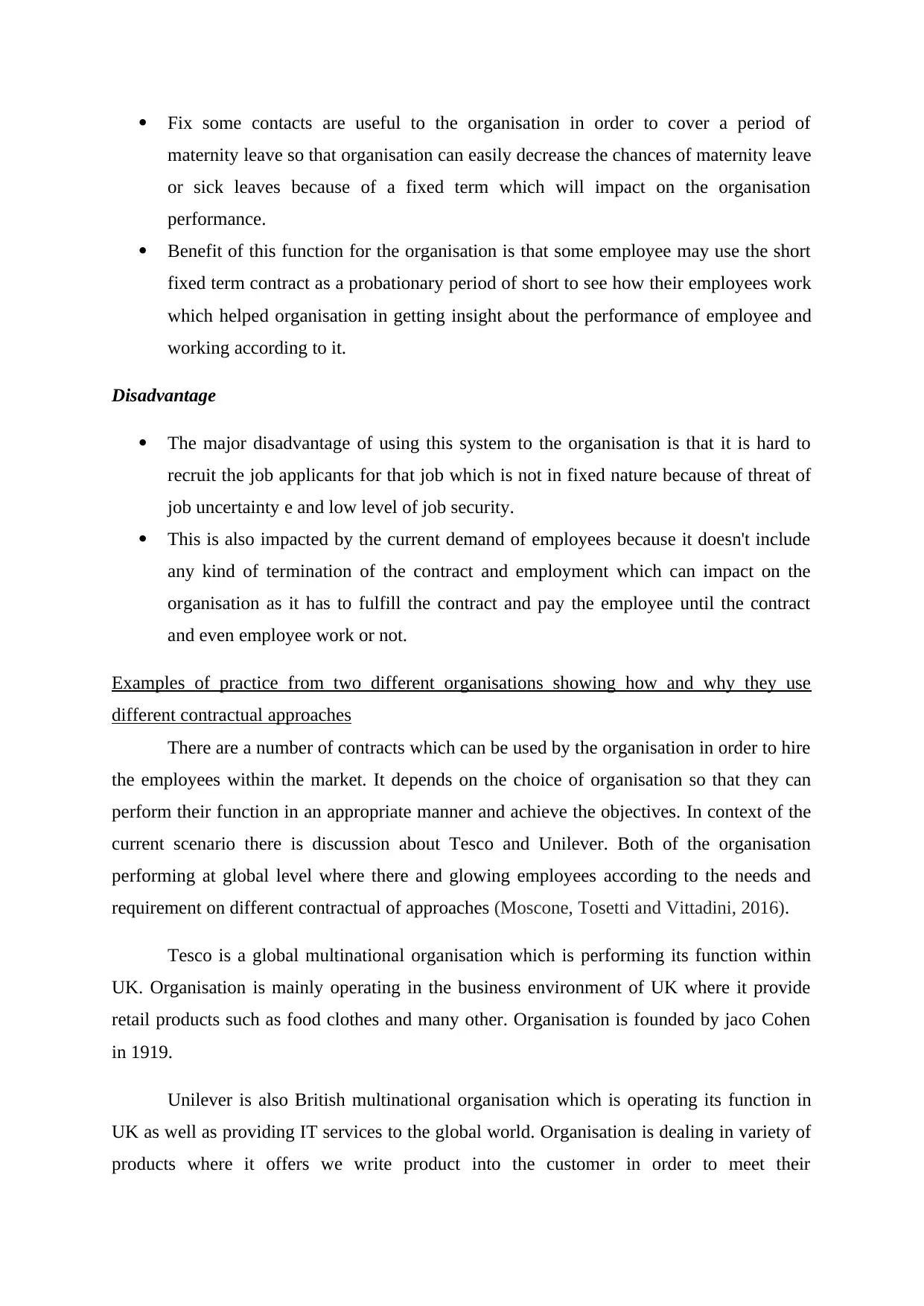
Fix some contacts are useful to the organisation in order to cover a period of
maternity leave so that organisation can easily decrease the chances of maternity leave
or sick leaves because of a fixed term which will impact on the organisation
performance.
Benefit of this function for the organisation is that some employee may use the short
fixed term contract as a probationary period of short to see how their employees work
which helped organisation in getting insight about the performance of employee and
working according to it.
Disadvantage
The major disadvantage of using this system to the organisation is that it is hard to
recruit the job applicants for that job which is not in fixed nature because of threat of
job uncertainty e and low level of job security.
This is also impacted by the current demand of employees because it doesn't include
any kind of termination of the contract and employment which can impact on the
organisation as it has to fulfill the contract and pay the employee until the contract
and even employee work or not.
Examples of practice from two different organisations showing how and why they use
different contractual approaches
There are a number of contracts which can be used by the organisation in order to hire
the employees within the market. It depends on the choice of organisation so that they can
perform their function in an appropriate manner and achieve the objectives. In context of the
current scenario there is discussion about Tesco and Unilever. Both of the organisation
performing at global level where there and glowing employees according to the needs and
requirement on different contractual of approaches (Moscone, Tosetti and Vittadini, 2016).
Tesco is a global multinational organisation which is performing its function within
UK. Organisation is mainly operating in the business environment of UK where it provide
retail products such as food clothes and many other. Organisation is founded by jaco Cohen
in 1919.
Unilever is also British multinational organisation which is operating its function in
UK as well as providing IT services to the global world. Organisation is dealing in variety of
products where it offers we write product into the customer in order to meet their
maternity leave so that organisation can easily decrease the chances of maternity leave
or sick leaves because of a fixed term which will impact on the organisation
performance.
Benefit of this function for the organisation is that some employee may use the short
fixed term contract as a probationary period of short to see how their employees work
which helped organisation in getting insight about the performance of employee and
working according to it.
Disadvantage
The major disadvantage of using this system to the organisation is that it is hard to
recruit the job applicants for that job which is not in fixed nature because of threat of
job uncertainty e and low level of job security.
This is also impacted by the current demand of employees because it doesn't include
any kind of termination of the contract and employment which can impact on the
organisation as it has to fulfill the contract and pay the employee until the contract
and even employee work or not.
Examples of practice from two different organisations showing how and why they use
different contractual approaches
There are a number of contracts which can be used by the organisation in order to hire
the employees within the market. It depends on the choice of organisation so that they can
perform their function in an appropriate manner and achieve the objectives. In context of the
current scenario there is discussion about Tesco and Unilever. Both of the organisation
performing at global level where there and glowing employees according to the needs and
requirement on different contractual of approaches (Moscone, Tosetti and Vittadini, 2016).
Tesco is a global multinational organisation which is performing its function within
UK. Organisation is mainly operating in the business environment of UK where it provide
retail products such as food clothes and many other. Organisation is founded by jaco Cohen
in 1919.
Unilever is also British multinational organisation which is operating its function in
UK as well as providing IT services to the global world. Organisation is dealing in variety of
products where it offers we write product into the customer in order to meet their
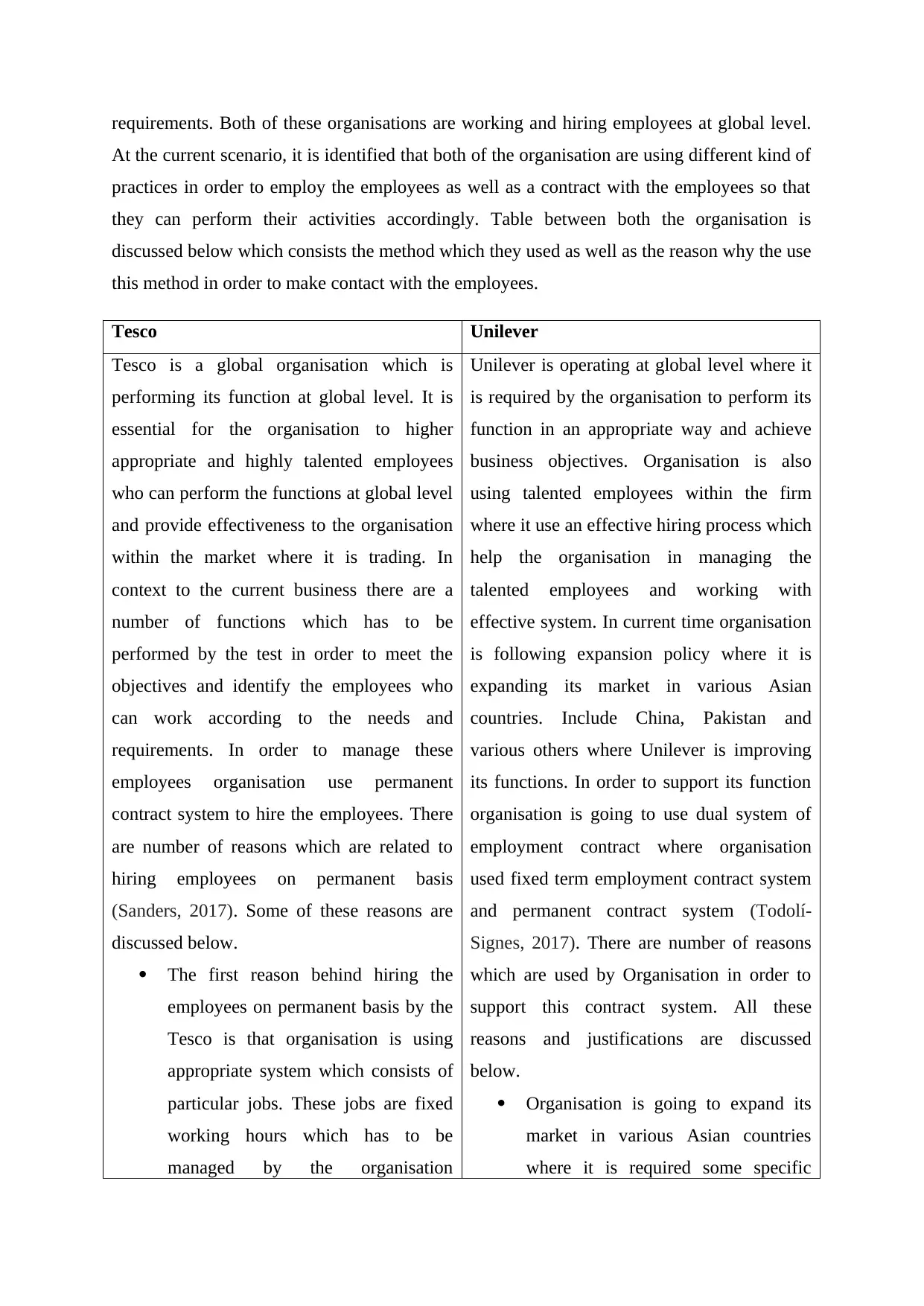
requirements. Both of these organisations are working and hiring employees at global level.
At the current scenario, it is identified that both of the organisation are using different kind of
practices in order to employ the employees as well as a contract with the employees so that
they can perform their activities accordingly. Table between both the organisation is
discussed below which consists the method which they used as well as the reason why the use
this method in order to make contact with the employees.
Tesco Unilever
Tesco is a global organisation which is
performing its function at global level. It is
essential for the organisation to higher
appropriate and highly talented employees
who can perform the functions at global level
and provide effectiveness to the organisation
within the market where it is trading. In
context to the current business there are a
number of functions which has to be
performed by the test in order to meet the
objectives and identify the employees who
can work according to the needs and
requirements. In order to manage these
employees organisation use permanent
contract system to hire the employees. There
are number of reasons which are related to
hiring employees on permanent basis
(Sanders, 2017). Some of these reasons are
discussed below.
The first reason behind hiring the
employees on permanent basis by the
Tesco is that organisation is using
appropriate system which consists of
particular jobs. These jobs are fixed
working hours which has to be
managed by the organisation
Unilever is operating at global level where it
is required by the organisation to perform its
function in an appropriate way and achieve
business objectives. Organisation is also
using talented employees within the firm
where it use an effective hiring process which
help the organisation in managing the
talented employees and working with
effective system. In current time organisation
is following expansion policy where it is
expanding its market in various Asian
countries. Include China, Pakistan and
various others where Unilever is improving
its functions. In order to support its function
organisation is going to use dual system of
employment contract where organisation
used fixed term employment contract system
and permanent contract system (Todolí-
Signes, 2017). There are number of reasons
which are used by Organisation in order to
support this contract system. All these
reasons and justifications are discussed
below.
Organisation is going to expand its
market in various Asian countries
where it is required some specific
At the current scenario, it is identified that both of the organisation are using different kind of
practices in order to employ the employees as well as a contract with the employees so that
they can perform their activities accordingly. Table between both the organisation is
discussed below which consists the method which they used as well as the reason why the use
this method in order to make contact with the employees.
Tesco Unilever
Tesco is a global organisation which is
performing its function at global level. It is
essential for the organisation to higher
appropriate and highly talented employees
who can perform the functions at global level
and provide effectiveness to the organisation
within the market where it is trading. In
context to the current business there are a
number of functions which has to be
performed by the test in order to meet the
objectives and identify the employees who
can work according to the needs and
requirements. In order to manage these
employees organisation use permanent
contract system to hire the employees. There
are number of reasons which are related to
hiring employees on permanent basis
(Sanders, 2017). Some of these reasons are
discussed below.
The first reason behind hiring the
employees on permanent basis by the
Tesco is that organisation is using
appropriate system which consists of
particular jobs. These jobs are fixed
working hours which has to be
managed by the organisation
Unilever is operating at global level where it
is required by the organisation to perform its
function in an appropriate way and achieve
business objectives. Organisation is also
using talented employees within the firm
where it use an effective hiring process which
help the organisation in managing the
talented employees and working with
effective system. In current time organisation
is following expansion policy where it is
expanding its market in various Asian
countries. Include China, Pakistan and
various others where Unilever is improving
its functions. In order to support its function
organisation is going to use dual system of
employment contract where organisation
used fixed term employment contract system
and permanent contract system (Todolí-
Signes, 2017). There are number of reasons
which are used by Organisation in order to
support this contract system. All these
reasons and justifications are discussed
below.
Organisation is going to expand its
market in various Asian countries
where it is required some specific
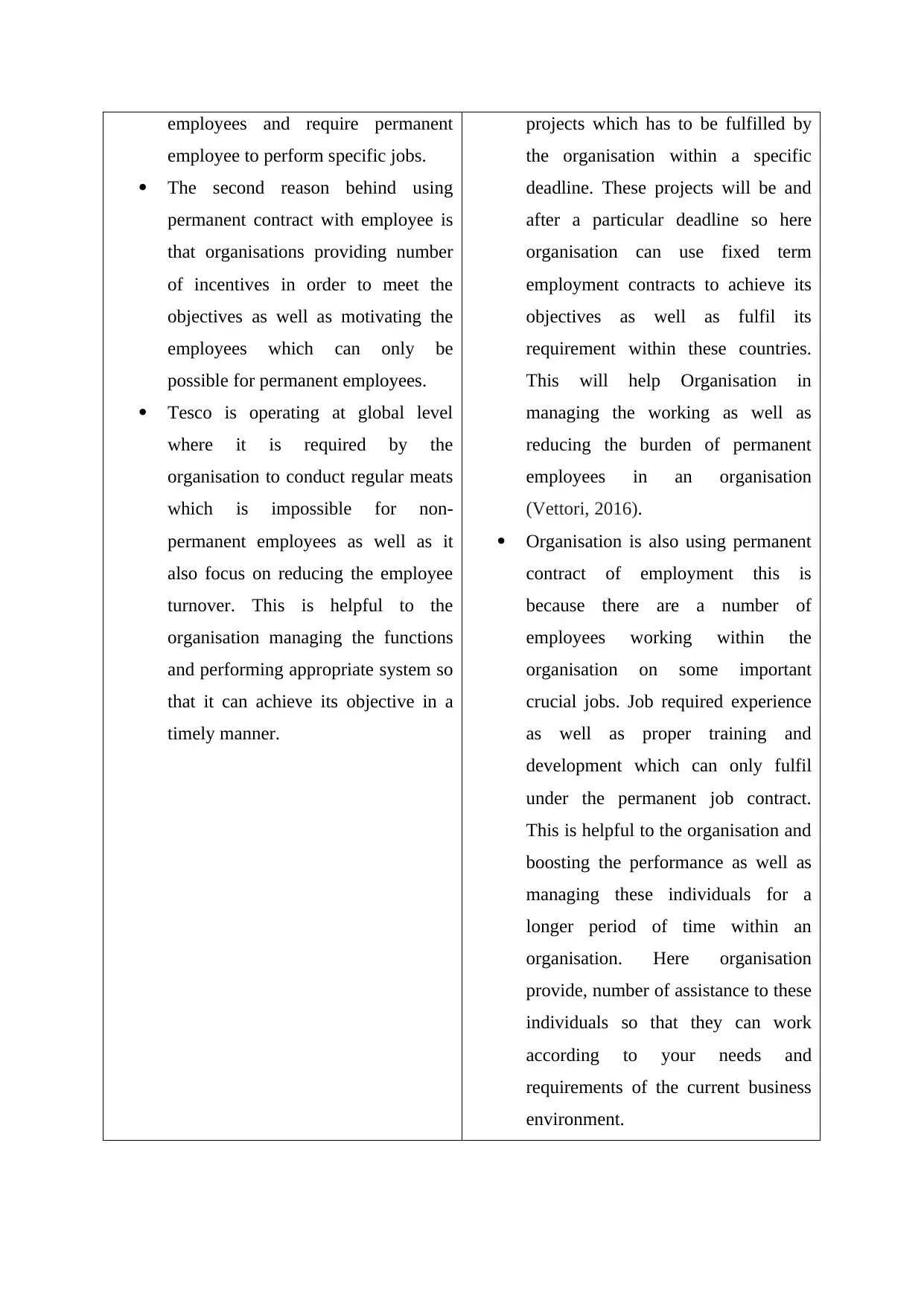
employees and require permanent
employee to perform specific jobs.
The second reason behind using
permanent contract with employee is
that organisations providing number
of incentives in order to meet the
objectives as well as motivating the
employees which can only be
possible for permanent employees.
Tesco is operating at global level
where it is required by the
organisation to conduct regular meats
which is impossible for non-
permanent employees as well as it
also focus on reducing the employee
turnover. This is helpful to the
organisation managing the functions
and performing appropriate system so
that it can achieve its objective in a
timely manner.
projects which has to be fulfilled by
the organisation within a specific
deadline. These projects will be and
after a particular deadline so here
organisation can use fixed term
employment contracts to achieve its
objectives as well as fulfil its
requirement within these countries.
This will help Organisation in
managing the working as well as
reducing the burden of permanent
employees in an organisation
(Vettori, 2016).
Organisation is also using permanent
contract of employment this is
because there are a number of
employees working within the
organisation on some important
crucial jobs. Job required experience
as well as proper training and
development which can only fulfil
under the permanent job contract.
This is helpful to the organisation and
boosting the performance as well as
managing these individuals for a
longer period of time within an
organisation. Here organisation
provide, number of assistance to these
individuals so that they can work
according to your needs and
requirements of the current business
environment.
employee to perform specific jobs.
The second reason behind using
permanent contract with employee is
that organisations providing number
of incentives in order to meet the
objectives as well as motivating the
employees which can only be
possible for permanent employees.
Tesco is operating at global level
where it is required by the
organisation to conduct regular meats
which is impossible for non-
permanent employees as well as it
also focus on reducing the employee
turnover. This is helpful to the
organisation managing the functions
and performing appropriate system so
that it can achieve its objective in a
timely manner.
projects which has to be fulfilled by
the organisation within a specific
deadline. These projects will be and
after a particular deadline so here
organisation can use fixed term
employment contracts to achieve its
objectives as well as fulfil its
requirement within these countries.
This will help Organisation in
managing the working as well as
reducing the burden of permanent
employees in an organisation
(Vettori, 2016).
Organisation is also using permanent
contract of employment this is
because there are a number of
employees working within the
organisation on some important
crucial jobs. Job required experience
as well as proper training and
development which can only fulfil
under the permanent job contract.
This is helpful to the organisation and
boosting the performance as well as
managing these individuals for a
longer period of time within an
organisation. Here organisation
provide, number of assistance to these
individuals so that they can work
according to your needs and
requirements of the current business
environment.
Secure Best Marks with AI Grader
Need help grading? Try our AI Grader for instant feedback on your assignments.
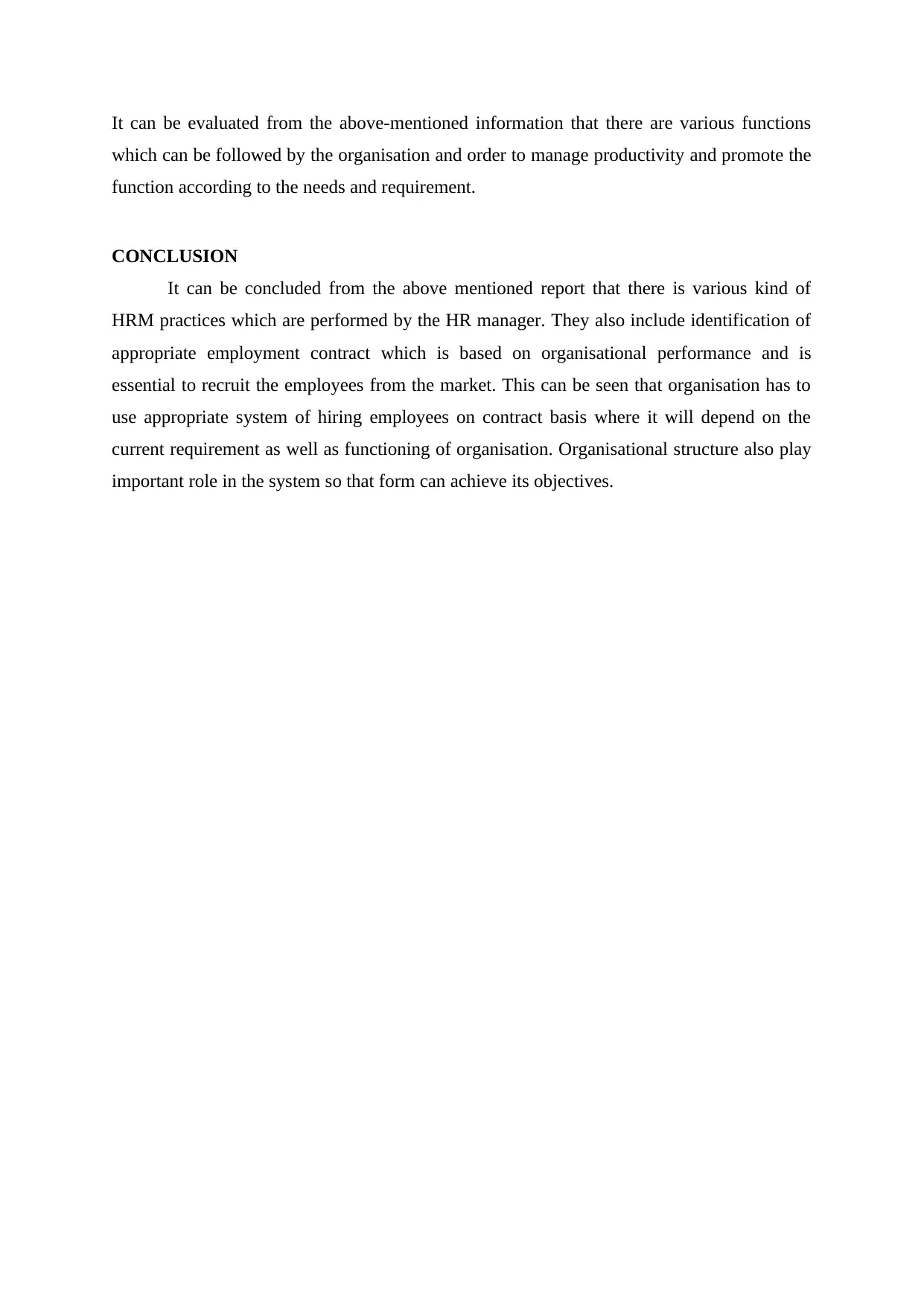
It can be evaluated from the above-mentioned information that there are various functions
which can be followed by the organisation and order to manage productivity and promote the
function according to the needs and requirement.
CONCLUSION
It can be concluded from the above mentioned report that there is various kind of
HRM practices which are performed by the HR manager. They also include identification of
appropriate employment contract which is based on organisational performance and is
essential to recruit the employees from the market. This can be seen that organisation has to
use appropriate system of hiring employees on contract basis where it will depend on the
current requirement as well as functioning of organisation. Organisational structure also play
important role in the system so that form can achieve its objectives.
which can be followed by the organisation and order to manage productivity and promote the
function according to the needs and requirement.
CONCLUSION
It can be concluded from the above mentioned report that there is various kind of
HRM practices which are performed by the HR manager. They also include identification of
appropriate employment contract which is based on organisational performance and is
essential to recruit the employees from the market. This can be seen that organisation has to
use appropriate system of hiring employees on contract basis where it will depend on the
current requirement as well as functioning of organisation. Organisational structure also play
important role in the system so that form can achieve its objectives.
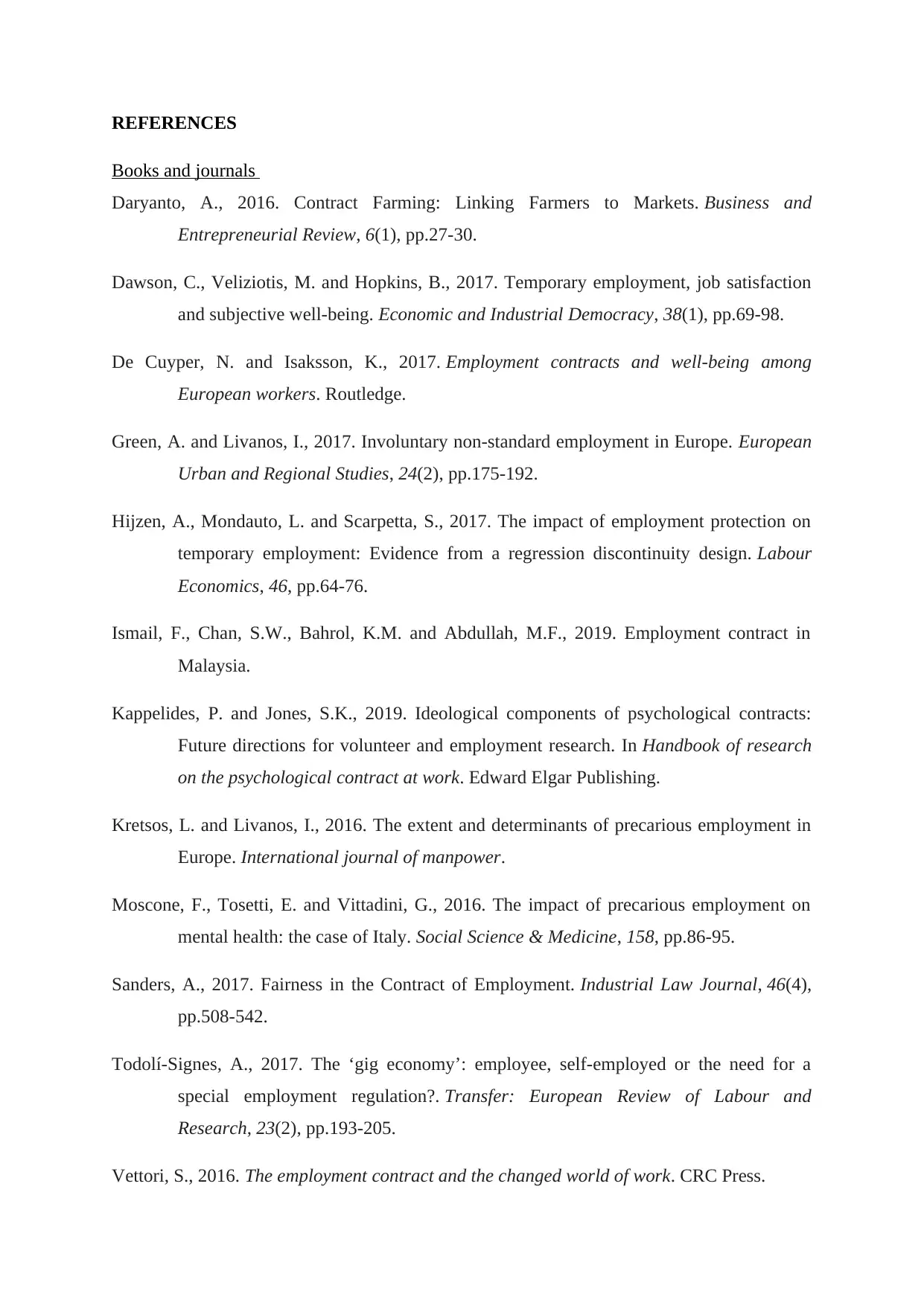
REFERENCES
Books and journals
Daryanto, A., 2016. Contract Farming: Linking Farmers to Markets. Business and
Entrepreneurial Review, 6(1), pp.27-30.
Dawson, C., Veliziotis, M. and Hopkins, B., 2017. Temporary employment, job satisfaction
and subjective well-being. Economic and Industrial Democracy, 38(1), pp.69-98.
De Cuyper, N. and Isaksson, K., 2017. Employment contracts and well-being among
European workers. Routledge.
Green, A. and Livanos, I., 2017. Involuntary non-standard employment in Europe. European
Urban and Regional Studies, 24(2), pp.175-192.
Hijzen, A., Mondauto, L. and Scarpetta, S., 2017. The impact of employment protection on
temporary employment: Evidence from a regression discontinuity design. Labour
Economics, 46, pp.64-76.
Ismail, F., Chan, S.W., Bahrol, K.M. and Abdullah, M.F., 2019. Employment contract in
Malaysia.
Kappelides, P. and Jones, S.K., 2019. Ideological components of psychological contracts:
Future directions for volunteer and employment research. In Handbook of research
on the psychological contract at work. Edward Elgar Publishing.
Kretsos, L. and Livanos, I., 2016. The extent and determinants of precarious employment in
Europe. International journal of manpower.
Moscone, F., Tosetti, E. and Vittadini, G., 2016. The impact of precarious employment on
mental health: the case of Italy. Social Science & Medicine, 158, pp.86-95.
Sanders, A., 2017. Fairness in the Contract of Employment. Industrial Law Journal, 46(4),
pp.508-542.
Todolí-Signes, A., 2017. The ‘gig economy’: employee, self-employed or the need for a
special employment regulation?. Transfer: European Review of Labour and
Research, 23(2), pp.193-205.
Vettori, S., 2016. The employment contract and the changed world of work. CRC Press.
Books and journals
Daryanto, A., 2016. Contract Farming: Linking Farmers to Markets. Business and
Entrepreneurial Review, 6(1), pp.27-30.
Dawson, C., Veliziotis, M. and Hopkins, B., 2017. Temporary employment, job satisfaction
and subjective well-being. Economic and Industrial Democracy, 38(1), pp.69-98.
De Cuyper, N. and Isaksson, K., 2017. Employment contracts and well-being among
European workers. Routledge.
Green, A. and Livanos, I., 2017. Involuntary non-standard employment in Europe. European
Urban and Regional Studies, 24(2), pp.175-192.
Hijzen, A., Mondauto, L. and Scarpetta, S., 2017. The impact of employment protection on
temporary employment: Evidence from a regression discontinuity design. Labour
Economics, 46, pp.64-76.
Ismail, F., Chan, S.W., Bahrol, K.M. and Abdullah, M.F., 2019. Employment contract in
Malaysia.
Kappelides, P. and Jones, S.K., 2019. Ideological components of psychological contracts:
Future directions for volunteer and employment research. In Handbook of research
on the psychological contract at work. Edward Elgar Publishing.
Kretsos, L. and Livanos, I., 2016. The extent and determinants of precarious employment in
Europe. International journal of manpower.
Moscone, F., Tosetti, E. and Vittadini, G., 2016. The impact of precarious employment on
mental health: the case of Italy. Social Science & Medicine, 158, pp.86-95.
Sanders, A., 2017. Fairness in the Contract of Employment. Industrial Law Journal, 46(4),
pp.508-542.
Todolí-Signes, A., 2017. The ‘gig economy’: employee, self-employed or the need for a
special employment regulation?. Transfer: European Review of Labour and
Research, 23(2), pp.193-205.
Vettori, S., 2016. The employment contract and the changed world of work. CRC Press.

1 out of 13
Related Documents
Your All-in-One AI-Powered Toolkit for Academic Success.
+13062052269
info@desklib.com
Available 24*7 on WhatsApp / Email
![[object Object]](/_next/static/media/star-bottom.7253800d.svg)
Unlock your academic potential
© 2024 | Zucol Services PVT LTD | All rights reserved.





